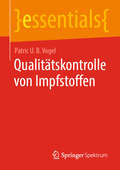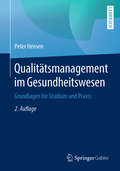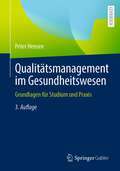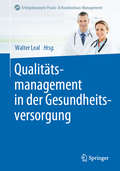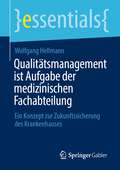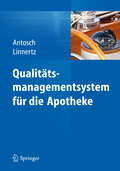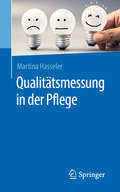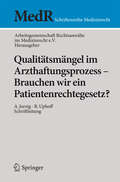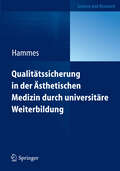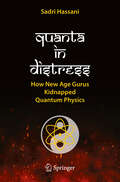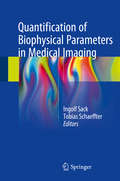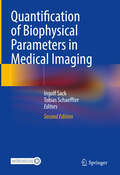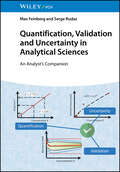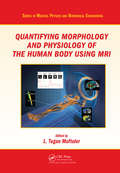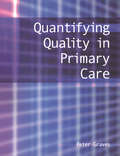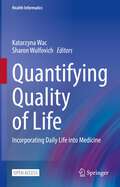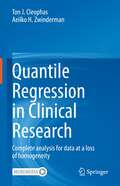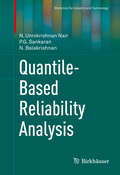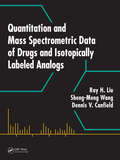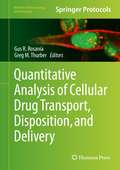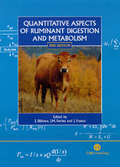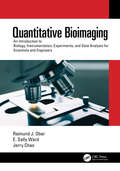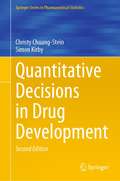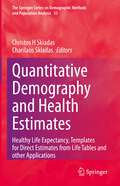- Table View
- List View
Qualitätskontrolle von Impfstoffen (essentials)
by Patric U. VogelIn diesem Buch wird die Qualitätskontrolle von Impfstoffen dargestellt. Hierzu zählen neben der Durchführung von analytischen Prüfungen verschiedenste qualitätsrelevante Aufgaben, z.B. die Festlegung von Qualitätsanforderungen, die Analyse von unerwarteten Ergebnissen oder Stabilitätsuntersuchungen, die die Qualitätskontroll-Einheit erfüllen muss. Die Abläufe sind hochreguliert und dienen der Patientensicherheit. Es gibt aber auch Beispiele, bei denen trotz erfolgreicher Qualitätskontrolle Qualitätsmängel möglich sind, die Schaden verursachen können.
Qualitätsmanagement im Gesundheitswesen: Grundlagen für Studium und Praxis
by Peter HensenMit dem Lehrbuch wird ein grundlegendes Verständnis für die Inhalte und Methoden des (umfassenden) Qualitätsmanagements und ihren Anwendungsbezug im Gesundheitswesen vermittelt. Ausgehend von der Vielschichtigkeit des Qualitätsbegriffs im Gesundheitswesen werden grundsätzliche Fragen wertorientierter Unternehmensführung, methodische Ansätze der einrichtungsinternen Qualitätsmessung und Qualitätsbewertung, aber auch Konzepte professionsbezogener Qualitätsentwicklung und einrichtungsübergreifender Qualitätsvergleiche adressiert. Für Studierende ist es wichtig, die grundlegenden Prinzipien dieses Themenbereichs zu verstehen und sich mit den unterschiedlichen Konzepten, Standpunkten und Methoden auseinanderzusetzen. Das Lehrbuch legt seinen Schwerpunkt daher gezielt auf die theoretische Fundierung und die Methodenvielfalt dieses Fachs. Der vorlesungsorientierte Aufbau ermöglicht jedem Leser, sich schrittweise die grundlegenden Kenntnisse und das dazugehörige Verständnis zu erarbeiten. Die Kapitelstruktur lädt darüber hinaus zur gezielten Vertiefung von Teilaspekten ein.Die zweite Auflage wurde aktualisiert und in einigen Abschnitten überarbeitet und inhaltlich vertieft.
Qualitätsmanagement im Gesundheitswesen: Grundlagen für Studium und Praxis
by Peter HensenMit dem Lehrbuch wird ein grundlegendes Verständnis für die Inhalte und Methoden des (umfassenden) Qualitätsmanagements und ihren Anwendungsbezug im Gesundheitswesen vermittelt. Ausgehend von der Vielschichtigkeit des Qualitätsbegriffs im Gesundheitswesen werden grundsätzliche Fragen wertorientierter Unternehmensführung, methodische Ansätze der einrichtungsinternen Qualitätsbestimmung und Qualitätsgestaltung sowie Konzepte professionsbezogener Qualitätsentwicklung und einrichtungsübergreifender Qualitätsvergleiche adressiert. Für Studierende ist es wichtig, die Prinzipien dieses Themenbereichs zu verstehen und sich mit den unterschiedlichen Konzepten, Standpunkten und Methoden auseinanderzusetzen. Das Lehrbuch legt seinen Schwerpunkt daher gezielt auf die theoretische Fundierung und die Methodenvielfalt dieses Fachs. Der vorlesungsorientierte Aufbau ermöglicht den Leserinnen und Lesern, sich schrittweise die grundlegenden Kenntnisse und das dazugehörige Verständnis zu erarbeiten. Die dritte Auflage wurde umfassend aktualisiert, in einigen Abschnitten überarbeitet und inhaltlich vertieft. Als Einstiegshilfe und als Nachschlagewerk richtet sich dieses Buch gleichermaßen an Studierende und praktisch Tätige, insbesondere an Angehörige der Gesundheitsberufe und der kaufmännischen Berufe im Gesundheitswesen.
Qualitätsmanagement in der Gesundheitsversorgung (Erfolgskonzepte Praxis- & Krankenhaus-Management)
by Walter LealQualitätsmanagement, vor allem im Medizin- und Gesundheitswesen, ist ein Thema von zentraler Bedeutung. Durch effiziente Qualitätsmanagementsysteme, die u.a. auch Optimierungen von Prozessen beinhalten, können die Risiken von Fehlern reduziert werden. Qualitätsmanagementsysteme sorgen dafür, dass Patienten die Dienstleistungen mit hoher Fachkompetenz, Hygiene und Sicherheit erhalten. Ein gutes Qualitätsmanagement hilft Einrichtungen im Bereich Gesundheit dabei, Kunden zu binden, neue Marktanteile zu sichern und auch wirtschaftlich zu funktionieren. Mit diesem Buch wird eine wichtige Lücke geschlossen. Es zeigt auf, wie Qualitätsmanagement im Bereich Gesundheit ganzheitlich umgesetzt werden kann und verbindet Theorie und Praxis. Mit konkreten Beispielen bezüglich Planung, Lenkung, Kontrolle und Verbesserung der Prozesse. Die unterschiedlichen Dimensionen des Qualitätsmanagements werden dargestellt: Prozessoptimierungen und Schnittstellenmanagement, CIRS als Werkzeug des Qualitäts- und Risikomanagements, Qualifizierung der Mitarbeiter, Marketing und Benchmarking, Beschwerdemanagement, QM und Digitalisierung, Aufnahme- und Entlassungsmanagement … Qualitätsmanagement aus Sicht von Gesundheitseinrichtungen, Patienten und Kostenträgern. Das Buch bietet eine breite Wissens-Grundlage für die Führungskräfte und Entscheidungsträger in Medizin, Politik und Wirtschaft und soll ein besseres gegenseitiges Verständnis und wirksames gemeinsames Handeln anregen.
Qualitätsmanagement ist Aufgabe der medizinischen Fachabteilung: Ein Konzept zur Zukunftssicherung des Krankenhauses (essentials)
by Wolfgang HellmannQualitätsmanagement in Krankenhäusern bedarf in einer Zeit massiven Personal- und Finanzmangels eines Paradigmenwechsels. Personal- und kostenintensive kommerzielle QM-Systeme sind nicht mehr zeitgemäß, einfache Lösungen hingegen erforderlich. Die medizinischen Fachabteilungen sind deshalb mehr denn je gefordert, Qualitätsmanagement und damit verbunden Patientensicherheit im Kontext ihrer originären Aufgabe, der Sicherung hoher Behandlungsqualität, erfolgreich umzusetzen. Dieses essential stellt ein einfaches Konzept auf Basis der Identifizierung von Defiziten und der Bereitstellung von Praxistipps zur Optimierung vor. Handliche Checklisten erleichtern die Umsetzung im Klinikalltag.
Qualitätsmanagementsystem für die Apotheke
by Bernadette Linnertz Peter AntoschDie überarbeitete Apothekenbetriebsordnung verpflichtet alle Apotheken zu einem Qualitätsmanagementsystem (QMS). Dieser übersichtlich gestaltete und praxisorientierte Leitfaden gibt Apotheken alle wichtigen Details an die Hand, um ein QMS erfolgreich einzuführen und auszubauen. Die erfahrenen Autoren zeigen von der Analyse der Ausgangssituation bis hin zur Unterstützung bei Systemeinführung die Vorteile des QMS. Checklisten, Beispiele, Hinweise auf potenzielle Fehler und komprimierte Zusammenfassungen leisten wertvolle Hilfe bei der Umsetzung.
Qualitätsmessung in der Pflege
by Martina HasselerGute Pflege ist ein dynamischer Prozess!Was ist pflegerische Qualität und welche Indikatoren definieren sie? Welche Einflussfaktoren verändern sie? Dieses Buch zeigt Führungskräften pflegerischer Einrichtungen, sowie Professoren, Studierenden und Meinungsgebern im Gesundheitswesen, anhand eines theoretischen Konstrukts, den dynamischen Prozess der Qualitätsentwicklung in der Pflege. Die Autorin führt den aktuellen Stand der Diskussion aus und bindet wichtige Einflussfaktoren wie Personalmanagement und Führungskompetenzen mit ein.
Qualitätsmängel im Arzthaftungsprozess - Brauchen wir ein Patientenrechtegesetz? (MedR Schriftenreihe Medizinrecht)
by ArbeitsgemeinschaftNach ca. 20-jähriger Diskussion soll nunmehr auf Bundesebene ein Patientenrechtegesetz verabschiedet werden. Mit dem Gesetz wird das Ziel verfolgt, Transparenz über die Rechte der Patientinnen und Patienten herzustellen, die Durchsetzung dieser Rechte zu verbessern sowie Patientinnen und Patienten im Sinne einer verbesserten Gesundheitsversorgung zu schützen und im Falle eines Behandlungsfehlers stärker zu unterstützen. Das XXIII. Kölner Symposium der Arbeitsgemeinschaft Medizinrecht formuliert Fragen und Referate, ob ein Patientenrechtegesetz wegen möglicher Qualitätsmängel im Arzthaftungsprozess notwendig ist und ob das diskutierte Patientenrechtegesetz tatsächlich dem Anspruch gerecht wird, diese Patientenrechte zu stärken. Ist die Rechtsposition des Patienten ausreichend, wenn es um die Anhörung des Sachverständigen geht? Sind Neuregelungen über die Aufklärungspflicht des Arztes erforderlich oder genügt die Rechtsprechung zur Aufklärung, um das Selbstbestimmungsrecht des Patienten sicherzustellen? Die Beiträge behandeln sowohl materiell-rechtliche als auch zivilprozessuale Rechtsfragen, die das Arzt- und Patientenverhältnis im Arzthaftungsprozess betreffen. Auch wenn im Ergebnis wohl festgestellt werden muss, dass das diskutierte Patientenrechtegesetz einen "Mangel an legislativer Eigenständigkeit" (Prof. Dr. Dieter Hart, Universität Bremen) belegt, so wird die Diskussion um die Patientenrechte speziell im Arzthaftungsprozess anhalten.
Qualitätssicherung in der Ästhetischen Medizin durch universitäre Weiterbildung
by Stefan HammesMit dem Buch werden die Standards für eine interdisziplinäre, universitäre und praxisorientierte Ausbildung in der ästhetischen Lasermedizin definiert. Das Beispiel des ersten Weiterbildungsstudienganges in Deutschland mit dem universitären Abschluss Diploma in Aesthetic Laser Medicine (DALM) zeigt, wie das Risikomanagement in der ästhetischen Medizin konkrete Form annehmen kann. Der Band enthält einen Fragenkatalog zur Vorbereitung auf die Prüfung.
Quanta in Distress: How New Age Gurus Kidnapped Quantum Physics
by Sadri HassaniThis book deconstructs and debunks the lucrative and widespread marriage of quantum physics with pop-spirituality while tracing this pernicious strain of pseudoscience to its source: the founders of quantum mechanics themselves. The association of mystical ideas with modern physics in the self-improvement industry is not new. The “spookiness” of quantum properties like uncertainty and entanglement has proven fertile ground for new-age mystics and alternative medicine advocates who saw a way to put a scientific veneer on their claims. In the early days, the founders of quantum physics accused it of implying an observer-created reality. Later, Taoists and Wu Li dancers were quantized. Then ancient Indian medicine, Ayurveda, morphed into “quantum healing.” Little wonder The Oprah Winfrey Show told its viewers: think about losing weight, making more money, and falling in love, and you’ll become thin, wealthy, and happily married … all based on quantum physics. Criticism of the pseudoscientific misappropriation of quantum physics has been widespread but inadequate; thus far, the scientific community has failed to account for its own role in the fusion of pop-spirituality and quantum physics. As well as thoroughly exploring and debunking quantum mysticism, this book traces the development of quantum mysticism and pulls no punches in exposing the unwitting role of quantum theory’s founders in propagating quantum mysticism.
Quantification of Biophysical Parameters in Medical Imaging
by Ingolf Sack Tobias SchaeffterThis book provides a selection of essential knowledge on the image-based quantification of biophysical parameters for the purpose of clinical diagnosis. The authors regard clinical imaging scanners as physical measurement systems capable of quantifying intrinsic parameters for depiction of the constitution and biophysical properties of in vivo tissue. On the one hand, this approach supports the development of new methods of imaging highly reproducible, system-independent, and quantitative biomarkers, and these methods receive detailed attention in the book. On the other hand, the reader will also gain a deeper understanding of how physical tissue properties interact with the generation of signals in medical imaging, opening new windows on the intricate and fascinating relationship between the structure and function of living tissues. The book will be of interest to all who recognize the limitations of basing clinical diagnosis primarily on visual inspection of images and who wish to learn more about the diagnostic potential of quantitative and biophysics-based medical imaging markers and the challenges that the paucity of such markers poses for next-generation imaging technologies.
Quantification of Biophysical Parameters in Medical Imaging
by Ingolf Sack Tobias SchaeffterThe second edition of this book offers six new chapters covering the latest developments in quantitative medical imaging, including artificial intelligence, MRI mapping, sonography, elastography and cardiac CT. All the other existing chapters have been updated and expanded, many with new text and figures, to reflect the rapid translation and advancement of technology in this exciting area of biomedical research. This updated edition presents fundamental knowledge on the imaging quantification of biophysical parameters for clinical diagnostic purposes. Clinical imaging scanners are considered by the authors as physical measurement systems capable of quantifying intrinsic parameters for the representation of the constitution and biophysical properties of tissues in vivo. In one respect, this approach fosters the development of new imaging methods for highly reproducible, system-independent, and quantitative biomarkers. These methods are greatly detailed in the book. Alternatively, this new edition equips the reader with a better understanding of how the physical properties of tissues interact with signal generation in medical imaging, opening up new insights into the complex and fascinating relationship between structure and function in living tissues. This updated edition is of interest to all those who recognize the limitations of clinical diagnosis based primarily on visual inspection of images, and who wish to learn more about the diagnostic potential of quantitative, biophysically-based medical imaging markers, as well as the challenges posed by the scarcity of such markers for next-generation imaging technologies.
Quantification of Contrast Kinetics in Clinical Imaging (SpringerBriefs in Applied Sciences and Technology)
by Osama I. Soliman Folkert J. ten Cate Massimo Mischi Simona Turco Hessel Wijkstra Ivo SchootsThis book provides a comprehensive survey of the pharmacokinetic models used for the quantitative interpretation of contrast-enhanced imaging. It discusses all the available imaging technologies and the problems related to the calibration of the imaging system and accuracy of the estimated physiological parameters. Enhancing imaging modalities using contrast agents has opened up new opportunities for going beyond morphological information and enabling minimally invasive assessment of tissue and organ functionality down to the molecular level. In combination with mathematical modeling of the contrast agent kinetics, contrast- enhanced imaging has the potential to provide clinically valuable additional information by estimating quantitative physiological parameters. The book presents the broad spectrum of diagnostic possibilities provided by quantitative contrast-enhanced imaging, with a particular focus on cardiology and oncology, as well as novel developments in the area of quantitative molecular imaging along with their potential clinical applications. Given the variety of available techniques, the choice of the appropriate imaging modality and the most suitable pharmacokinetic model is often challenging. As such, the book provides a valuable technical guide for researchers, clinical scientists, and experts in the field who wish to better understand and properly apply tracer-kinetic modeling for quantitative contrast-enhanced imaging.
Quantification, Validation and Uncertainty in Analytical Sciences: An Analyst's Companion
by Max Feinberg Serge RudazQuantification, Validation and Uncertainty in Analytical Sciences Companion guide explaining all processes in measuring uncertainty in quantitative analytical results Quantification, Validation and Uncertainty in Analytical Sciences provides basic and expert knowledge by building on the sequence of operations starting from the quantification in analytical sciences by defining the analyte and linking it to the calibration function. Proposing a comprehensive approach to MU (Measurement Uncertainty) estimation, it empowers the reader to apply Method Accuracy Profile (MAP) efficiently as a statistical tool in measuring uncertainty. The text elucidates several examples and template worksheets explaining the theoretical aspects of the procedure and includes novel method validation procedures that can accurately estimate the data obtained in measurements. It also enables the reader to provide practical insights to improve decision making by accurately evaluating and comparing different analytical methods. Brings together an interdisciplinary approach with statistical tools and algorithms applied in analytical chemistry and written by two international experts with long-standing experience in the field of Analytical measurements and Uncertainty, Quantification, Validation and Uncertainty in Analytical Sciences includes information on: The know-how of methods in an analytical laboratory, effective usage of a spurious measurement and methods to estimate errors. Quantification, calibration, precision, trueness, MAP addons, estimating MU for analytical sciences, and uncertainty functionsEmploying measurement uncertainty, sampling uncertainty, quantification limits, and sample conformity assessmentDecision making, uncertainty and standard addition method, and accuracy profile for method comparison Quantification, Validation and Uncertainty in Analytical Sciences is an ideal resource for every individual quantifying or studying analytes. With several chapters dedicated to MU’s practical use in decision making demonstrating its advantages, the book is primarily intended for professional analysts, although researchers and students will also find it of interest.
Quantifying Morphology and Physiology of the Human Body Using MRI (Series in Medical Physics and Biomedical Engineering)
by L. Tugan MuftulerIn the medical imaging field, clinicians and researchers are increasingly moving from the qualitative assessment of printed images to the quantitative evaluation of digital images since the quantitative techniques often improve diagnostic accuracy and complement clinical assessments by providing objective criteria. Despite this growing interest, th
Quantifying Quality in Primary Care
by Peter GravesHow can the quality of service provision and clinical governance in primary care be assessed? This book is designed to help evaluate the way practices interpret their legal obligations, the way the management systems within practices run, and the quality of the systems and processes that most affect the patient care. Quantifying Quality in Primary Care contains frameworks on which to build policies for the smooth running of practices and provides clear insights into attitudes of those working within them, and how to use this information to improve service provision. This straightforward, concise guide will help general practitioners, registrars and managers in primary care improve both service provision and management in the practice.
Quantifying Quality of Life: Incorporating Daily Life into Medicine (Health Informatics)
by Katarzyna Wac Sharon WulfovichThis open access book presents the rise of technology-enabled methods and tools for objective, quantitative assessment of Quality of Life (QoL), while following the WHOQOL model. It is an in-depth resource describing and examining state-of-the-art, minimally obtrusive, ubiquitous technologies. Highlighting the required factors for adoption and scaling of technology-enabled methods and tools for QoL assessment, it also describes how these technologies can be leveraged for behavior change, disease prevention, health management and long-term QoL enhancement in populations at large. Quantifying Quality of Life: Incorporating Daily Life into Medicine fills a gap in the field of QoL by providing assessment methods, techniques and tools. These assessments differ from the current methods that are now mostly infrequent, subjective, qualitative, memory-based, context-poor and sparse. Therefore, it is an ideal resource for physicians, physicians in training, software and hardware developers, computer scientists, data scientists, behavioural scientists, entrepreneurs, healthcare leaders and administrators who are seeking an up-to-date resource on this subject.
Quantile Regression in Clinical Research: Complete analysis for data at a loss of homogeneity
by Aeilko H. Zwinderman Ton J. CleophasQuantile regression is an approach to data at a loss of homogeneity, for example (1) data with outliers, (2) skewed data like corona - deaths data, (3) data with inconstant variability, (4) big data. In clinical research many examples can be given like circadian phenomena, and diseases where spreading may be dependent on subsets with frailty, low weight, low hygiene, and many forms of lack of healthiness. Stratified analyses is the laborious and rather explorative way of analysis, but quantile analysis is a more fruitful, faster and completer alternative for the purpose. Considering all of this, we are on the verge of a revolution in data analysis. The current edition is the first textbook and tutorial of quantile regressions for medical and healthcare students as well as recollection/update bench, and help desk for professionals. Each chapter can be studied as a standalone and covers one of the many fields in the fast growing world of quantile regressions. Step by step analyses of over 20 data files stored at extras.springer.com are included for self-assessment. We should add that the authors are well qualified in their field. Professor Zwinderman is past-president of the International Society of Biostatistics (2012-2015) and Professor Cleophas is past-president of the American College of Angiology(2000-2002). From their expertise they should be able to make adequate selections of modern quantile regression methods for the benefit of physicians, students, and investigators.
Quantile-Based Reliability Analysis
by N. Balakrishnan P. G. Sankaran N. Unnikrishnan NairThis book provides a fresh approach to reliability theory, an area that has gained increasing relevance in fields from statistics and engineering to demography and insurance. Its innovative use of quantile functions gives an analysis of lifetime data that is generally simpler, more robust, and more accurate than the traditional methods, and opens the door for further research in a wide variety of fields involving statistical analysis. In addition, the book can be used to good effect in the classroom as a text for advanced undergraduate and graduate courses in Reliability and Statistics.
Quantitation and Mass Spectrometric Data of Drugs and Isotopically Labeled Analogs
by Ray H. Liu Dennis V. Canfield Sheng-Meng WangThe analysis of drugs and their metabolites in biological media are now expected to routinely achieve � 20% accuracy in the ng/mL concentration level. Therefore, the availability and the selection of quality ion-pairs designating the analytes and their isotopically labeled analogs (ILAs) are important considerations in achieving the accuracy of qua
Quantitative Analysis of Cellular Drug Transport, Disposition, and Delivery (Methods in Pharmacology and Toxicology)
by Gus R. Rosania Greg M. ThurberThis thorough book explores some of the most important methods and concepts affecting the quantitative analysis of the transport, targeting, and disposition of chemicals within cells, which in turn impact the macroscopic pharmacokinetics of chemical agents in the whole organism. The first half of the volume focuses on small organic molecules with drug-like characteristics, while the second half delves into the cellular pharmacokinetics of biologics and other macromolecules, including peptide therapeutics, cyclotides, antibodies, as well as nanoparticles, thus creating a comprehensive treatise that approaches cellular pharmacokinetics from the different perspectives of pharmaceutical scientists, chemical biologists, medicinal chemists, and protein engineers dealing with very different chemical agents spanning a wide range of sizes, physicochemical properties, and targeting mechanisms. Written for the Methods in Pharmacology and Toxicology series, chapters provide the kind of key detail and expert implementation advice that leads to excellent results in the lab. Synthetic biologists, biophysicists, and bioengineers are amongst the long list of scientists who could benefit from reading this book or from using it as a textbook. Authoritative and practical, Quantitative Analysis of Cellular Drug Transport, Disposition, and Delivery builds on a long history of drug development and the adding of quantitative methods at the cellular scale in order to inspire new approaches to drug development that are better able to take advantage of phenomena such as soluble-to-insoluble phase transitions or bispecific targeting, which could ultimately be exploited for the development of more effective drug delivery systems and therapeutic agents.
Quantitative Aspects of Ruminant Digestion and Metabolism (2nd edition)
by J. M. Forbes J. Dijkstra J. FranceA comprehensive review of the digestion and metabolism of ruminant animals. Since its publication, much new research has been conducted in the subject and knowledge has increased. This new edition includes Dr. Dijkstra as an additional editor and four completely new chapters. These cover: the gas production technique in feed evaluation; the relationship between pasture characteristics and animal performance; calorimetry; and feed processing. Other chapters have been expanded or updated as appropriate.
Quantitative Bioimaging: An Introduction to Biology, Instrumentation, Experiments, and Data Analysis for Scientists and Engineers
by Raimund J. Ober E. Sally Ward Jerry ChaoQuantitative bioimaging is a broad interdisciplinary field that exploits tools from biology, chemistry, optics, and statistical data analysis for the design and implementation of investigations of biological processes. Instead of adopting the traditional approach of focusing on just one of the component disciplines, this textbook provides a unique introduction to quantitative bioimaging that presents all of the disciplines in an integrated manner. The wide range of topics covered include basic concepts in molecular and cellular biology, relevant aspects of antibody technology, instrumentation and experimental design in fluorescence microscopy, introductory geometrical optics and diffraction theory, and parameter estimation and information theory for the analysis of stochastic data. Key Features: Comprises four parts, the first of which provides an overview of the topics that are developed from fundamental principles to more advanced levels in the other parts. Presents in the second part an in-depth introduction to the relevant background in molecular and cellular biology and in physical chemistry, which should be particularly useful for students without a formal background in these subjects. Provides in the third part a detailed treatment of microscopy techniques and optics, again starting from basic principles. Introduces in the fourth part modern statistical approaches to the determination of parameters of interest from microscopy data, in particular data generated by single molecule microscopy experiments. Uses two topics related to protein trafficking (transferrin trafficking and FcRn-mediated antibody trafficking) throughout the text to motivate and illustrate microscopy techniques. An online appendix providing the background and derivations for various mathematical results presented or used in the text is available at http://www.routledge.com/9781138598980.
Quantitative Decisions in Drug Development (Springer Series in Pharmaceutical Statistics)
by Christy Chuang-Stein Simon KirbyThis book focuses on important decision points and evidence needed for making decisions at these points during the development of a new drug. It takes a holistic approach towards drug development by incorporating explicitly knowledge learned from the earlier part of the development and available historical information into decisions at later stages. In addition, the book shares lessons learned from several select examples published in the literature since the publication of the first edition. The second edition reiterates the need for making evidence-based Go/No Go decisions in drug development discussed in the first edition. It substantially expands several topics that have seen great advances since the publication of the first edition. The most noticeable additions include three adaptive trials conducted in recent years that offer excellent learning opportunities, the use of historical data in the design and analysis of clinical trials, and extending decision criteria to the cases when the primary endpoint is binary. The examples used to illustrate the additional materials all come from real trials with some post-trial reflections offered by the authors. The book begins with an overview of product development and regulatory approval pathways. It then discusses how to incorporate prior knowledge into study design and decision making at different stages of drug development. Prior knowledge includes information pertaining to historical controls. To assist decision making, the book discusses appropriate metrics and the formulation of go/no-go decisions for progressing a drug candidate to the next development stage. Using the concept of the positive predictive value in the field of diagnostics, the book leads readers to the assessment of the probability that an investigational product is effective given positive study outcomes. Lastly, the book points out common mistakes made by drug developers under the current drug-development paradigm. The book offers useful insights to statisticians, clinicians, regulatory affairs managers and decision-makers in the pharmaceutical industry who have a basic understanding of the drug-development process and the clinical trials conducted to support drug-marketing authorization. The authors provide software codes for select analytical approaches discussed in the book. The book includes enough technical details to allow statisticians to replicate the quantitative illustrations so that they can generate information to facilitate decision-making themselves.
Quantitative Demography and Health Estimates: Healthy Life Expectancy, Templates for Direct Estimates from Life Tables and other Applications (The Springer Series on Demographic Methods and Population Analysis #55)
by Charilaos Skiadas Christos H SkiadasThis book provides new theoretic and applied material with focus on quantitative methods and data analysis techniques applied in demography, population studies, health issues and statistics. It discusses the quantitative techniques to estimate the healthy life expectancy by expanding the classical life tables to include the proportion with disability calculated from life tables, along with the Sullivan method. The provided templates apply immediately to the life tables from WHO, HMD, Eurostat and other life table providers. Furthermore, the book explores the possibility of creating new health indicators along with Covid-19 pandemic management, factors associated to loneliness and an alcohol indicator. Part of the book is devoted to mortality, epidemic models, and the supercentenarians age estimation. Data analysis and artificial intelligence methods are included to apply in demographic and socio-economic cases. By providing a methodology to cope with health problems in demography and society by quantifying important health parameters, this book is a valuable guide for researchers, theoreticians, and practitioners from various disciplines and especially health scientists, statisticians, economists, and sociologists.
